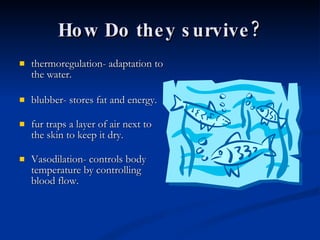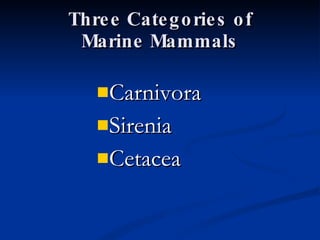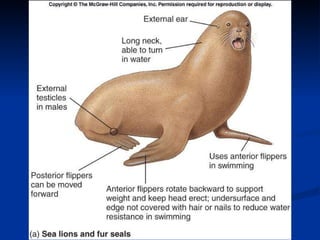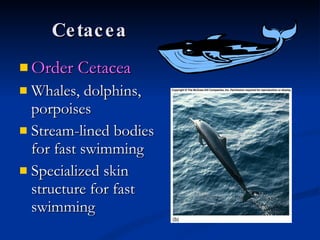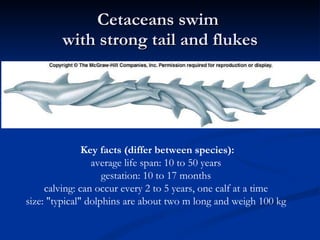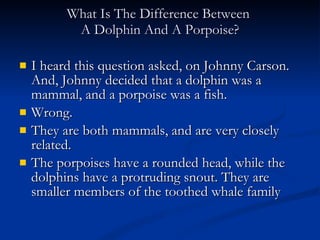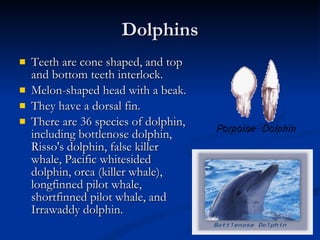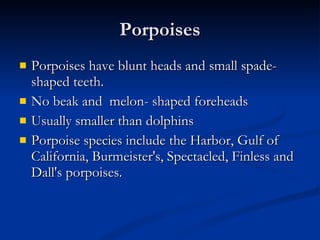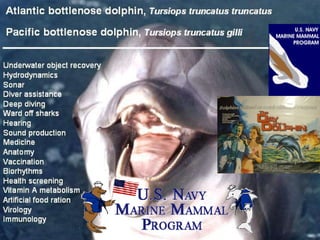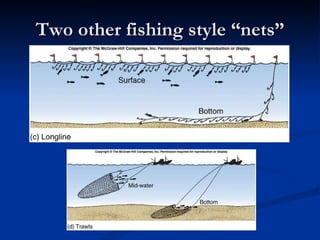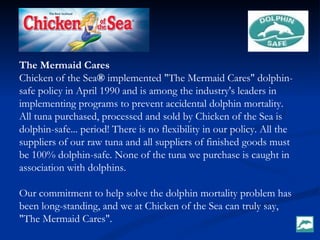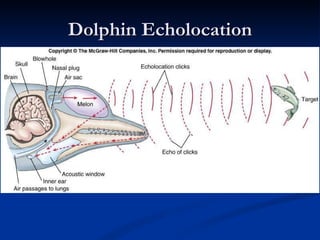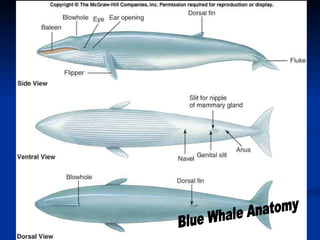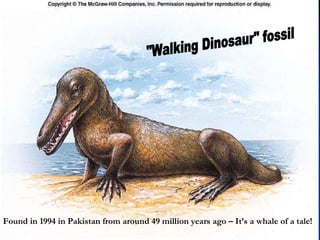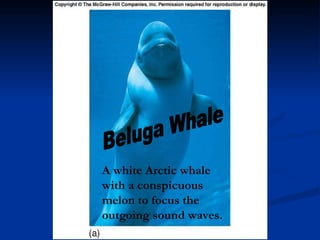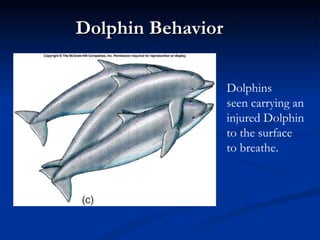Marine Mammals
- 2. Marine mammals Land-dwelling ancestors Warm-blooded Breathe air Hair/fur Bear live young Mammary glands for milk They all have 3 ear bones.
- 3. Other Interesting characteristics Most of them have different kinds of teeth 4 chambered hearts. highly developed brain.
- 4. Where Do they live? All over the ocean They migrate often based on seasons, breeding and feeding cycles. Some live in the Arctic (Polar Bears) Some live along the Pacific Coast (Sea Otters) Some live in the West Indies (Dugongs)
- 5. How Do they survive? thermoregulation- adaptation to the water. blubber- stores fat and energy. fur traps a layer of air next to the skin to keep it dry. Vasodilation- controls body temperature by controlling blood flow.
- 6. Three Categories of Marine Mammals Carnivora Sirenia Cetacea
- 7. Carnivora This order consists of: Seals Sea Lions Walruses Polar Bears Sea Otters
- 8. Carnivora Order Carnivora Prominent canine teeth Sea otters Polar bears Pinnepeds (large skin covered flippers) Walruses Seals Sea lions Fur seals
- 10. Figure 9.09b
- 12. Harems Stellar Sea Lions in “A” are the largest of the eared seals with males nearly 1 ton! In “B” a harem of California Sea Lions on Santa Barbara Island in S.Cal. The larger Elephant Seals are in the top of the picture.
- 13. “ I am the Walrus”
- 15. Sirenia (Sea Cows) Elephant-like ancestors Herbivores Manatees Coastal areas of tropical Atlantic Ocean Dugongs Coastal areas of Indian and western Pacific Oceans Slow, injured by boats
- 16. Figure 9.13
- 17. Cetacea Order Cetacea Whales, dolphins, porpoises Stream-lined bodies for fast swimming Specialized skin structure for fast swimming
- 18. Cetacea
- 20. Cetacea Adaptations for deep diving Use oxygen efficiently Absorb 90% of oxygen inhaled (lots of capillaries) Store large quantities of oxygen (lots of hemoglobin) Reduce oxygen required for noncritical organs Dive 10 min (dolphin) to 2 hours (Sperm Whale) Muscles insensitive to buildup of carbon dioxide Collapsible lungs
- 21. Cetacea Suborder Odontoceti (toothed) Dolphins, porpoises, Orca-killer whale, sperm whale Echolocation to determine distance and direction and size of objects
- 22. Baleen whales, larger than toothed whales Blue whale, finback whale, humpback whale, gray whale, right whale Fibrous plates of baleen sieve prey items Eat lower on food chain, krill,, zooplankton, etc Vocalized sounds for various purposes, low frequency communications, travel large (50 km) distances Cetacea Suborder Mysticeti
- 23. Figure 9.19b
- 24. Cetaceans swim with strong tail and flukes Key facts (differ between species): average life span: 10 to 50 years gestation: 10 to 17 months calving: can occur every 2 to 5 years, one calf at a time size: "typical" dolphins are about two m long and weigh 100 kg
- 25. What Is The Difference Between A Dolphin And A Porpoise? I heard this question asked, on Johnny Carson. And, Johnny decided that a dolphin was a mammal, and a porpoise was a fish. Wrong. They are both mammals, and are very closely related. The porpoises have a rounded head, while the dolphins have a protruding snout. They are smaller members of the toothed whale family
- 26. Dolphins Teeth are cone shaped, and top and bottom teeth interlock. Melon-shaped head with a beak. They have a dorsal fin. There are 36 species of dolphin, including bottlenose dolphin, Risso's dolphin, false killer whale, Pacific whitesided dolphin, orca (killer whale), longfinned pilot whale, shortfinned pilot whale, and Irrawaddy dolphin.
- 27. Porpoises Porpoises have blunt heads and small spade- shaped teeth. No beak and melon- shaped foreheads Usually smaller than dolphins Porpoise species include the Harbor, Gulf of California, Burmeister's, Spectacled, Finless and Dall's porpoises.
- 30. Why are dolphins affected by tuna fisheries? Yellow-fin tuna often school beneath large herds of spotted dolphins in the eastern Pacific Ocean. They both are feeding on surface-dwelling squids, mackerel and flying fish. When fishing nets are set beneath the dolphins to surround the tuna, dolphins and other by-catch also get tangled in the nets and die. Public pressure surrounding this controversial issue has prompted a 97 percent reduction of dolphin by-catch in the last seven years. Dolphins are only affected by the yellow-fin tuna fishery. Albacore tuna do not associate with dolphins.
- 31. Net tough on dolphins! Since 1990 the 3 top tuna packers agreed to not buy tuna from dolphin killing suppliers This net has now been changed so that dolphins are not harmed by US fisherman.
- 32. Drift net tough on dolphins!
- 33. Two other fishing style “nets”
- 34. The Mermaid Cares Chicken of the Sea ® implemented "The Mermaid Cares" dolphin-safe policy in April 1990 and is among the industry's leaders in implementing programs to prevent accidental dolphin mortality. All tuna purchased, processed and sold by Chicken of the Sea is dolphin-safe... period! There is no flexibility in our policy. All the suppliers of our raw tuna and all suppliers of finished goods must be 100% dolphin-safe. None of the tuna we purchase is caught in association with dolphins. Our commitment to help solve the dolphin mortality problem has been long-standing, and we at Chicken of the Sea can truly say, "The Mermaid Cares".
- 37. A dolphin giving “live” birth Viviparous = Live Birth
- 38. "Walking Dinosaur" fossil Found in 1994 in Pakistan from around 49 million years ago – It’s a whale of a tale!
- 39. Figure 9.31
- 40. Table 9.02
- 41. Strandings Strandings may be small-scale events involving single animals, or larger-scale events involving dozens of animals ("mass stranding"). Strandings may be routine, caused by commonly seen injuries or diseases, or extraordinary, caused by less common circumstances ("unusual mortality event"). Statistics of strandings
- 43. Which whales eat only large zooplankton? Which whale eats invertebrates near the ocean floor? Which whale eats large squid? Which whales eat pelagic fishes?
- 44. Figure 9.27a Beluga Whale A white Arctic whale with a conspicuous melon to focus the outgoing sound waves.
- 45. Whale Behavior Sperm whales surrounding an injured member of a pod
- 46. Whale Behavior Spying Behavior of Killer Whales
- 47. Dolphin Behavior Dolphins seen carrying an injured Dolphin to the surface to breathe.





